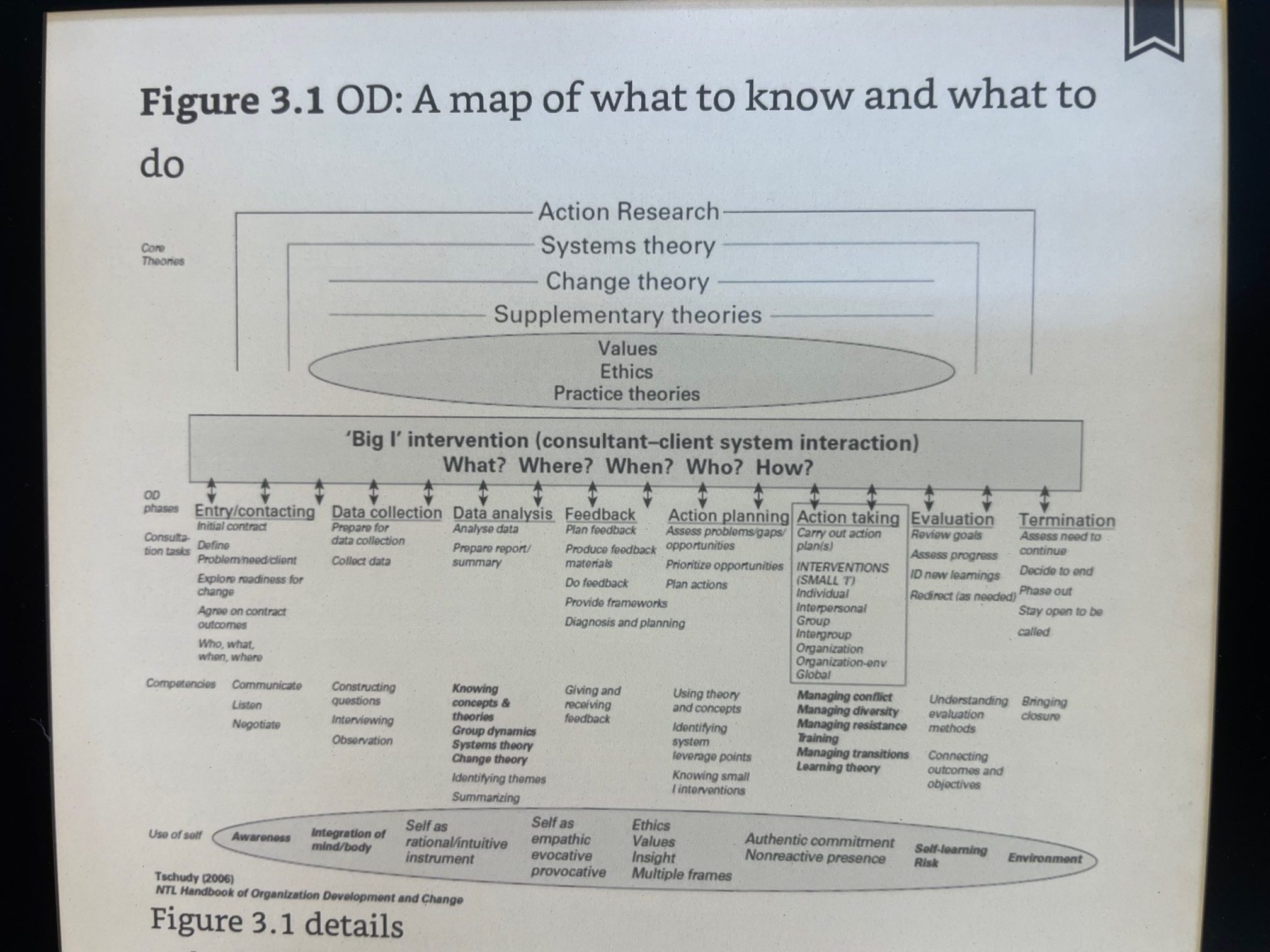
○8月2日(火)に、立教大学で開催される「OD勉強会」本の予習。
===
ORGANIZATION DEVELOPMENT: A PRACTITIONER’S GUIDE FOR OD AND HR
Mee-Yan Cheung-Judge、 Linda Holbeche(2021)
===
Section 1
OD history and theory overview
The field grew out of the values of the early founders, their ‘sense-making’ effort to understand human behaviour in the aftermath of the Second World War, and the research findings of applied behavioural science.
01 What is OD? Its brief history
Edgar Schein (1965) declared that all organizations, regardless of size and type, face two types of problems:
1)continuous external adaptation to a rapidly changing environment;
2)corresponding internal integration that will support the success of the external adaptation.
As twins to the strategists, OD practitioners are there to help the organization to prepare
itself internally to deliver the challenging external ambitions.
OD is about building and maintaining the health of the organization as a total system (Schein,1988a,b).
National Training Laboratory (NTL) on group dynamics and leadership: NTL was founded in the United States in 1947 to advance the field of applied behavioural science and to
develop change agents for effective leadership of organizations.
Pioneered in the United States by Lewin and his graduate students and in the UK by the Tavistock Institute, a T group is a small, unstructured group laboratory training in
which participants learn from their own actions and the group’s evolving dynamics.
Likert and Mann pioneered the first survey feedback with the Detroit Edison Company, using
survey results for improvement.
Lewin is the intellectual father of contemporary theories of applied behavioural science, action research and planned change.
Schein showed us that process consultation is an essential philosophy underlying OD, not
just a tool.
Robert Blake: During the Second World War, Blake served in the Psychological Research Unit of the Army Air Force and concluded that looking at the system rather than the individuals within the system on an isolated individual basis is a much more robust approach in identifying how best to help.
During the 1940s and 1950s, there were a number of strong movements sweeping through the world: the human relations movement, human potential movement, equality and diversity
movement, social participation (client rights, citizen rights) movement, etc
played a key role in shaping the field.
Such core values have been upheld as core OD values:
1)democracy and participation;
2)openness to lifelong learning and experimentation;
3)equity and fairness – the worth of every individual;
4)valid information and informed choice;
5)enduring respect for the human side of enterprise;
6)all human beings have the right to attain their potential.
The following ethical guidelines were pulled together as a summary of OD ethics.
Most of the time, the primary intervention for the third-party agent is to ‘suggest a
d facilitate participative processes for diagnostic data gathering, informed
decision making, and building client-system commitment for change (Marshak, 2006: 18).
Finally, one of the unique trademarks of OD is the concept of ‘self as instrument’.
02 Theories and practices of OD: a theory overview
As Lewin said, ‘Nothing is so practical as a good theory’. So from the 1940s through to the 1970s, research and practice were relatively closely connected.
Fig.2.1
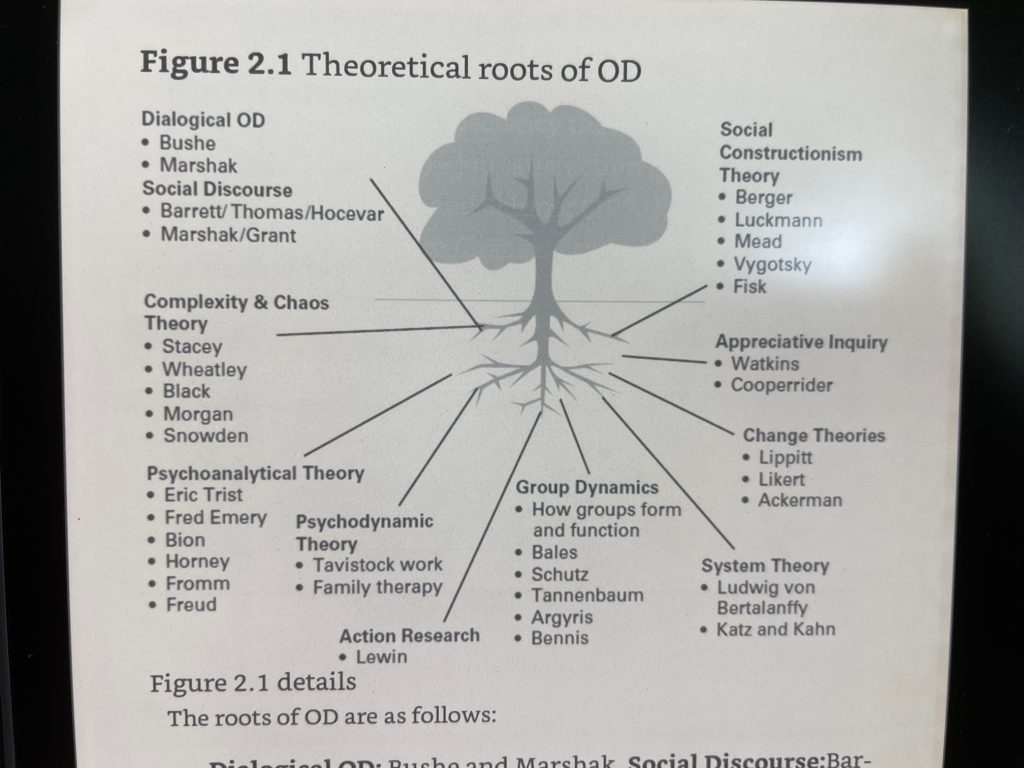
The eight core theories we will cover are:
1)Systems theory;
2)Action Research theory;
3)Change theories: Field theory, Group Dynamics and Three-step Model of Change;
4)Social Constructionism: Appreciative Inquiry;
5)Complexity and chaos theories;
6)Human Systems Dynamics (HSD);
7)Dialogic OD theory;
8)Social Discourse theory.
Action Research is a reiterative, cyclical, four-step process: diagnosing, planning, action
taking and evaluating action.
The word ‘dynamics’ comes from a Greek word meaning forces. So Group Dynamics refers to the
forces operating in groups.
Lewin’s Three-step Model – unfreezing, movement, refreezing – is highly related to Field theory.
However, he was very clear that unless sufficient psychological safety is created, the
disconfirming information will be denied or in other ways defended against,
no survival anxiety will be felt and consequently no change will occur.
Social Constructionism: All reality is socially constructed.
There are multiple realities, and what people focus on becomes their reality.
AI believes that in every organization there is something that works.
It is the leader’s job to create dialogue where people are encouraged to make sense of the
situation.
The task for us is to discover how people make sense of the world, not what the world is.
The significance of this theory for practitioners is its belief that if reality is socially
constructed, then it can be modified by injecting alternative conversations,
stories and narratives into the system.
All organizations face unknowable specific futures. Ability to learn is critical to navigate
through the unknown.
All organizations are paradoxes.
Human Systems Dynamics (HSD) is a theory-based practice for seeing, understanding and
influencing unpredictable change.
The process, called Adaptive Action, consists of three, simple questions: WHAT? to collect
observations and data; SO WHAT? to support sensemaking and innovation; and
NOW WHAT? to move towards action.
In HSD, four simple rules help practitioners practice inquiry in their personal and
professional lives:
1)Turn judgement into curiosity.
2)Turn conflict into shared exploration.
3)Turn defensiveness into self-reflection.
4)Turn assumptions into questions.
Connect with stories and impacts.
A basic assumption of Dialogic OD practices is that change occurs through changing the
conversations in a system.
Discourse is carried out through many different types of communicative practices, two of which are‘narrative’ and ‘conversation.
it is the combination of theories that will make the practitioner’s work successful. The brilliant thing about theories is that once they are understood, they can guide the
practitioner to do much better design, especially in real time.
Section 2 OD cycle of work
The OD cycle and its key phases is one of those original concepts that are critical in supporting practitioners to work effectively through the complex dynamics of any
consultancy work with clients.
In OD, the way we carry out evaluation is much more akin to the work of Michael Quinn Patton (2010) who introduced the term ‘developmental evaluation’ – which is the type of evaluation that informs and supports innovative and adaptive development in complex dynamic environments.
But summative (final) evaluation happens after all has been done already.
the evaluation process will become a powerful ongoing developmental intervention both for the immediate outcome as well as for changing the behaviour of the system members.
03 Theories and practices of OD: the OD cycle and the entry and contracting phase
Fig.3.1
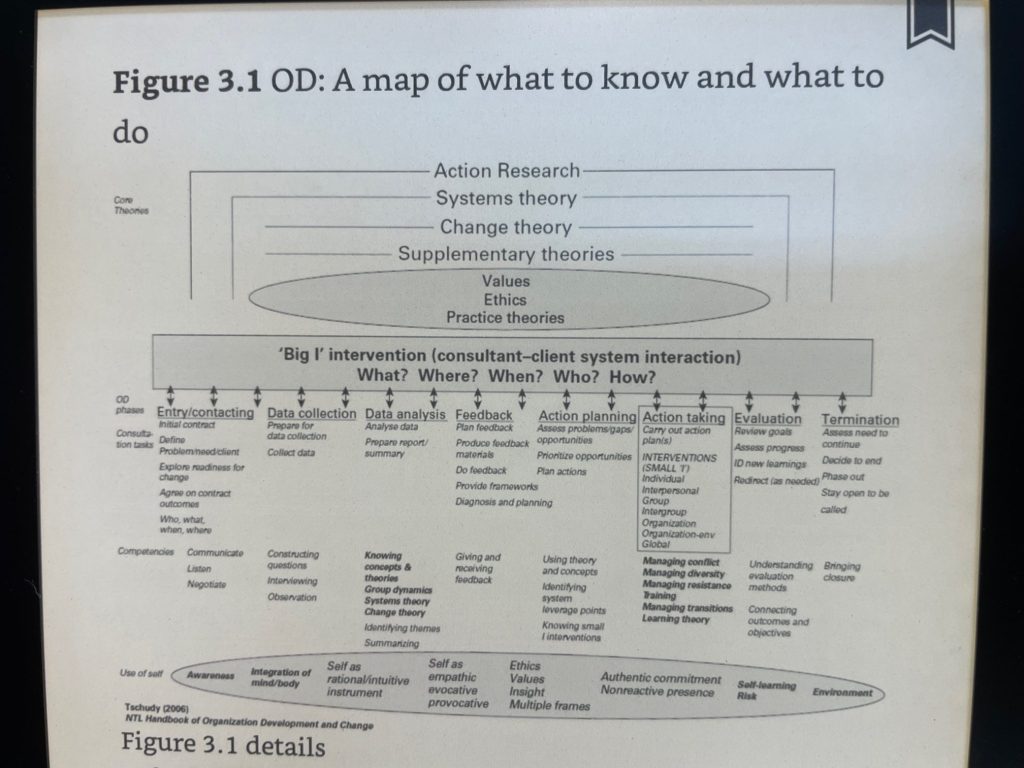
Phone or visit each client about six months after you have completed the project. It is a good idea to build this post-project visit (preferably at no cost to the client) into your formal contract.
OD practitioners need to have answers to three questions in order to construct a good contract:
1)Who is my client?
2)What is this job about? What are the tasks, the deliverables, the scope, the methods and the metrics that will indicate success (task contract)?
3)What type of relationship contract do I want and need to have with my key client(s) to ensure the success of the project (relationship contract)?
04 Theories and practices of OD: the diagnostic phase
The first task of the diagnostic phase for the OD practitioner is to collect ‘political’ data.
Who are the ‘right’ people (from your political data) to do data collection with you? Do they have the capability to carry out the task?
Nadler (1977) suggested that people often enter into data feedback sessions with some or all of the following feelings:
1)anxiety, a degree of uncertainty, not knowing exactly what to expect;
2)defensiveness, worry that they may hear something negative and may be attacked;
3)fear – people may have all sorts of reasons to be afraid, from undesirable outcomes to fear of retribution;
4)hope, that what they hear may improve the situation and be the beginning of a move
towards an exciting future.
It is also important to remember that diagnosis is never a pure data-gathering process.
05 Theories and practices of OD: the intervention phase
Fig.5 OD Cube
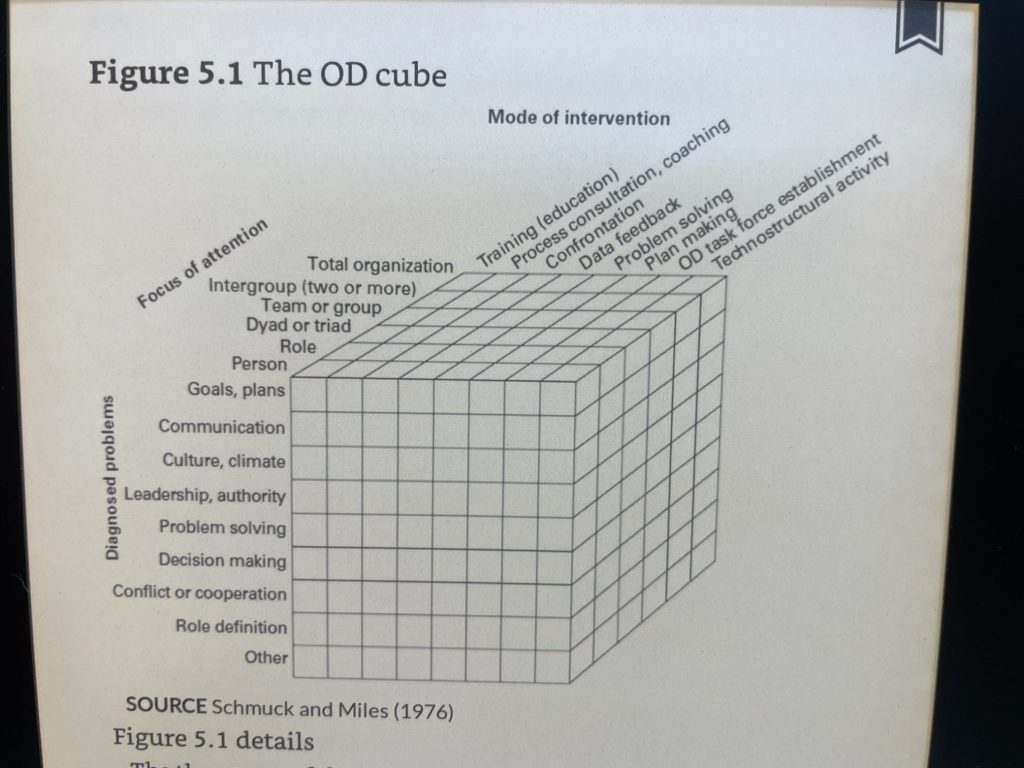
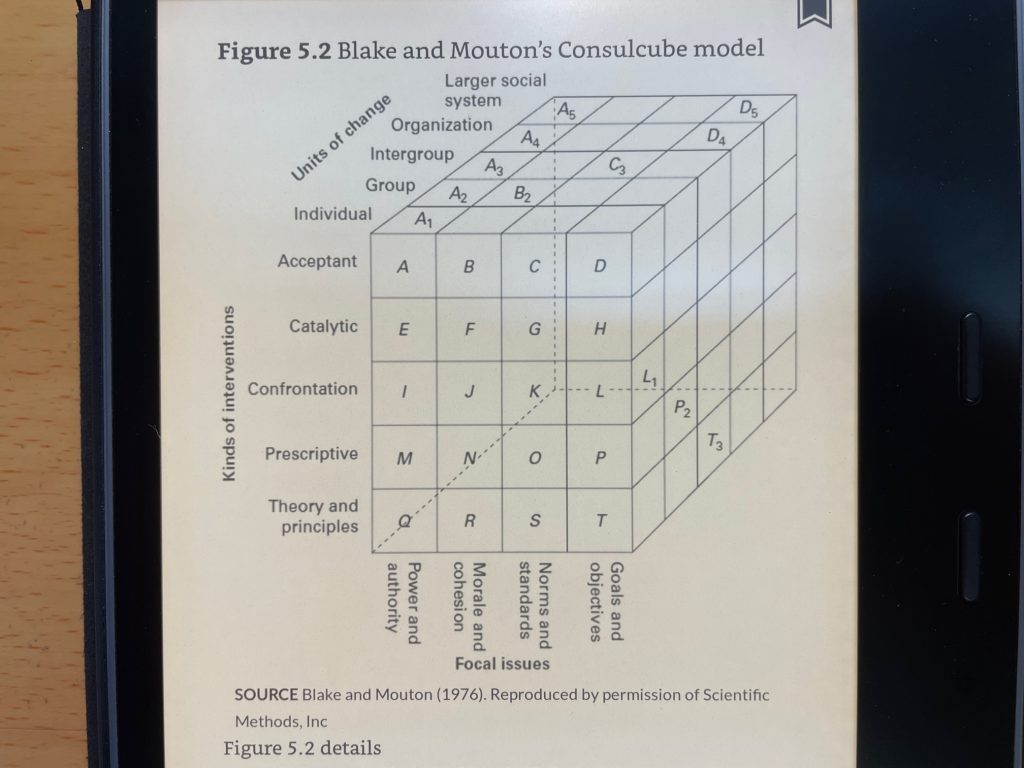
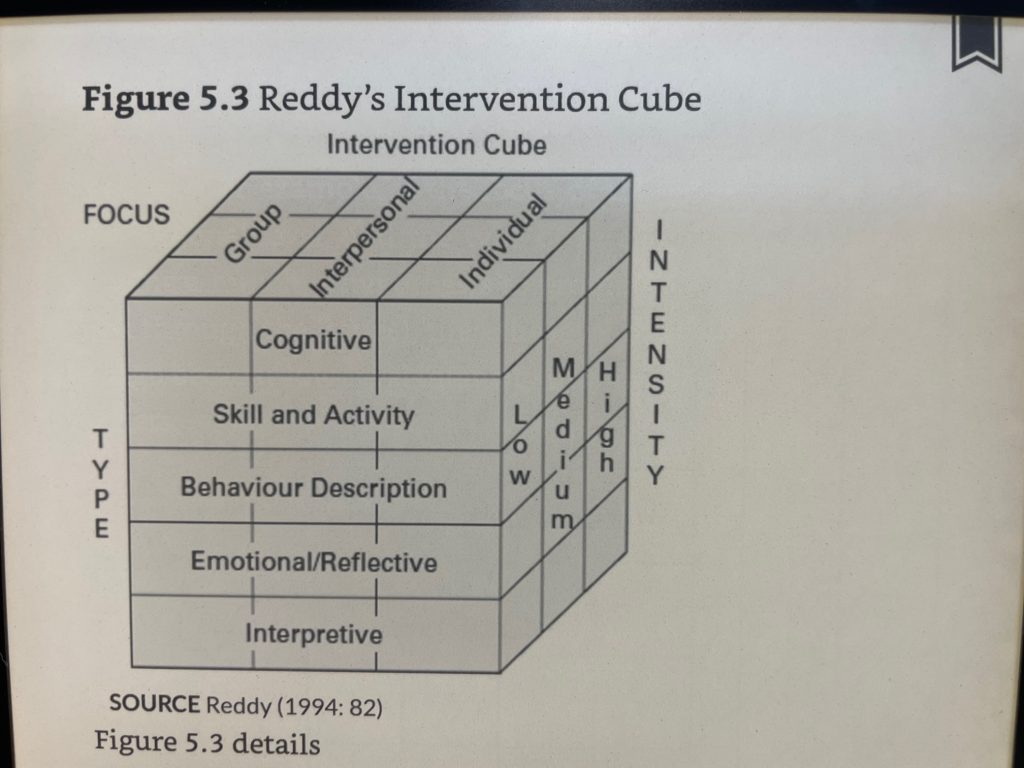
Fig.5.6 types of intervention
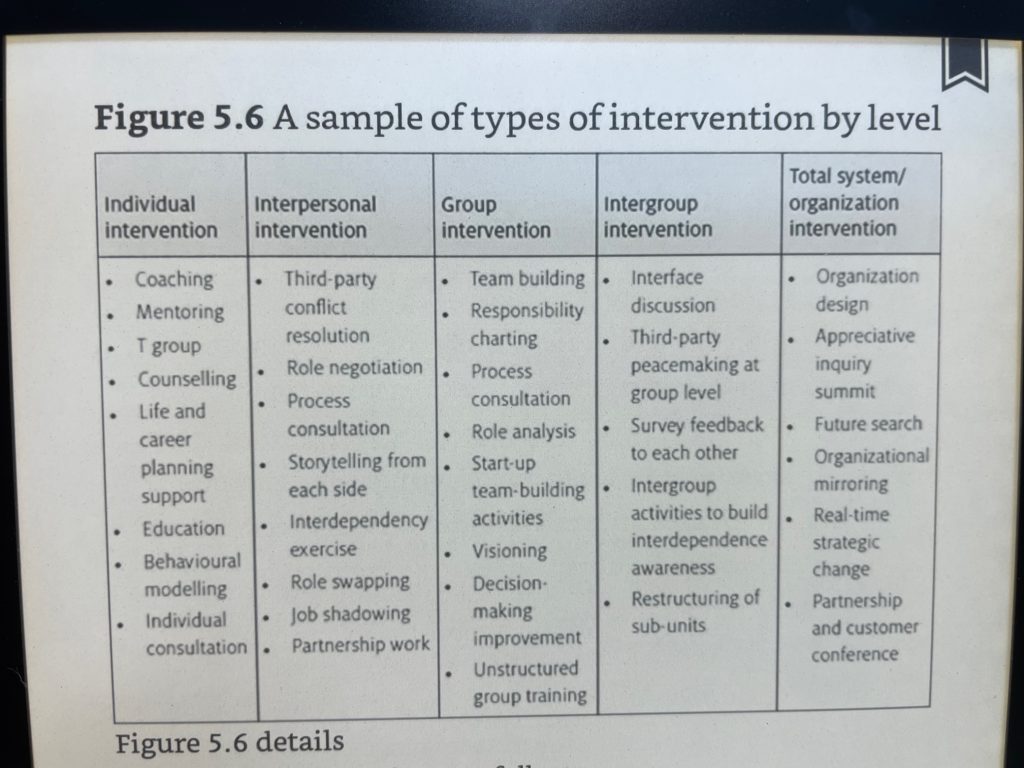
Intervention begins when we make contact with our clients; from then on, everything you say,
signal, hint, suggest and question begins to have an effect on the client system.
06 Theories and practices of OD: the evaluation phase
There are three roots of evaluation.
Fig.6.2
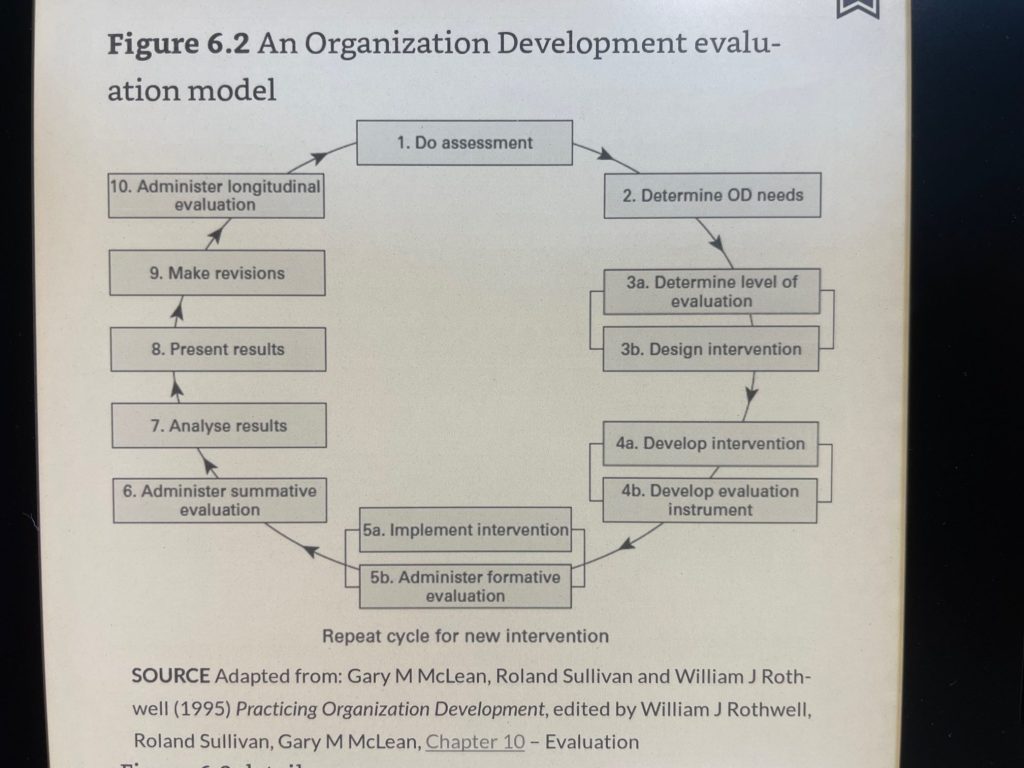
Evaluation is being undertaken at many levels, but certainly at the formative level (evaluation conducted during the intervention), summative level (evaluation conducted immediately after completion of the intervention) and the longitudinal level(evaluation conducted at a specified time after completion of the
intervention, eg after six months).
the OD perspective on evaluation is more like Patton’s concept of developmental evaluation. The analogy Patton used was cooking: ‘as we are cooking, we get to taste the sauce/soup.
While originally intended for the field of training, the four levels model for evaluation has been applied to a variety of change initiatives (Russ-Eft et al, 2008)
-Improved customer response time -Drop in customer complaint rate -Increased customer satisfaction rate -Increased sales -Improved customer retention rate
Fig.6.8
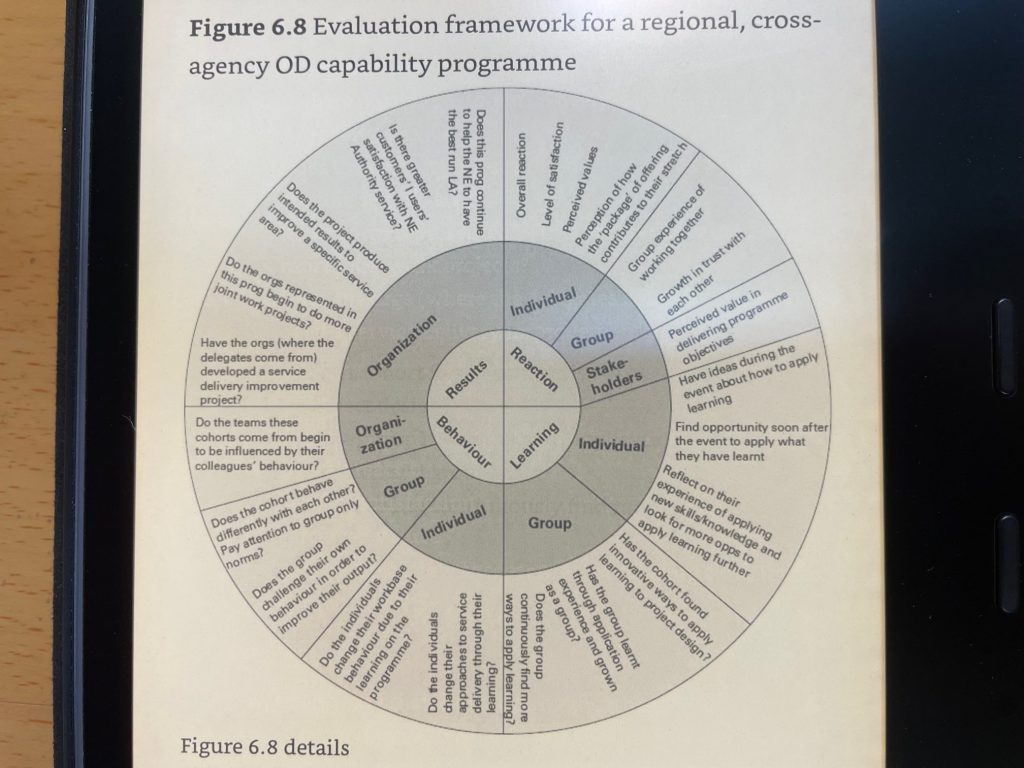
The classic work of Golembiewski et al (1976) helps to provide some insights to this debate.
According to them, there are three types of change results OD practitioners should aim for, and hence measure.
An alpha (α) change in a difference in a measure before and after an intervention.
A beta (β) change is a reassessment of the dimension in question.
A gamma (γ) change is a complete reframing, redefinition and re-conceptualization of the key domains that affect the team or organization.
Fig.6.10
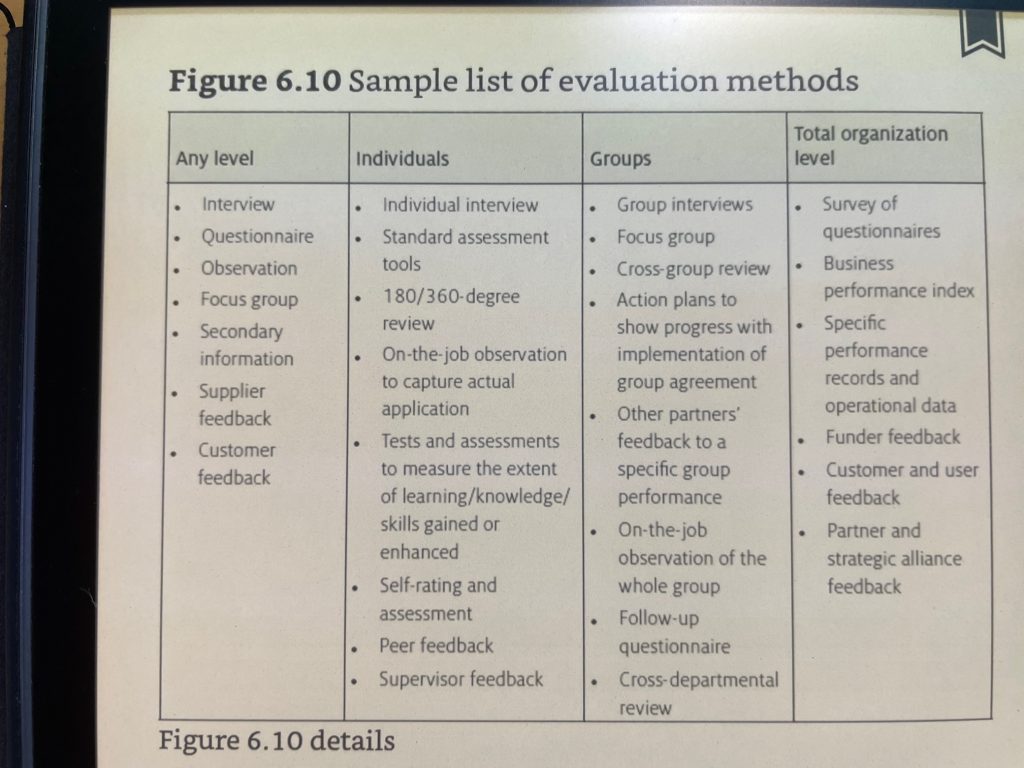
For OD to survive and thrive in these complicated times, you and I need to be more savvy in
measuring and demonstrating the effectiveness of our work.
Most of the senior leaders live in the ‘input’ and ‘output’world.
But what they seldom do is to pay attention to the ‘throughput’ – the alignment of the organizational internal variables to support the strategic priorities.
Next is to link OD initiatives and interventions to the core business areas that senior leaders are most concerned with.
Asking senior leaders to agree who should get involved will inevitably mean you will have on
the evaluation team some of the trusted protégés, and/or credible seconds-in-command of the senior leaders. Having nominated these people, the leaders will be more receptive to the data because they are trusted people – not HR or OD people
Section 3 OD and change
07 Living at the edge of chaos and change
complex adaptive system (CAS)
According to Glenda Eoyang from HSD (2010) through her teaching programme, ‘CAS is a collection of individual agents who have the freedom to act in unpredictable ways, and whose actions are interconnected such that one agent’s actions changes the context for other agents’
This list seems old-fashioned, as it is hard to imagine any organization still tackling their change situation with that set of assumptions, but surprisingly, the reasons why so many ODPs feel unsafe in working with change in organizations is because many organizations still do.
Fig.7.2
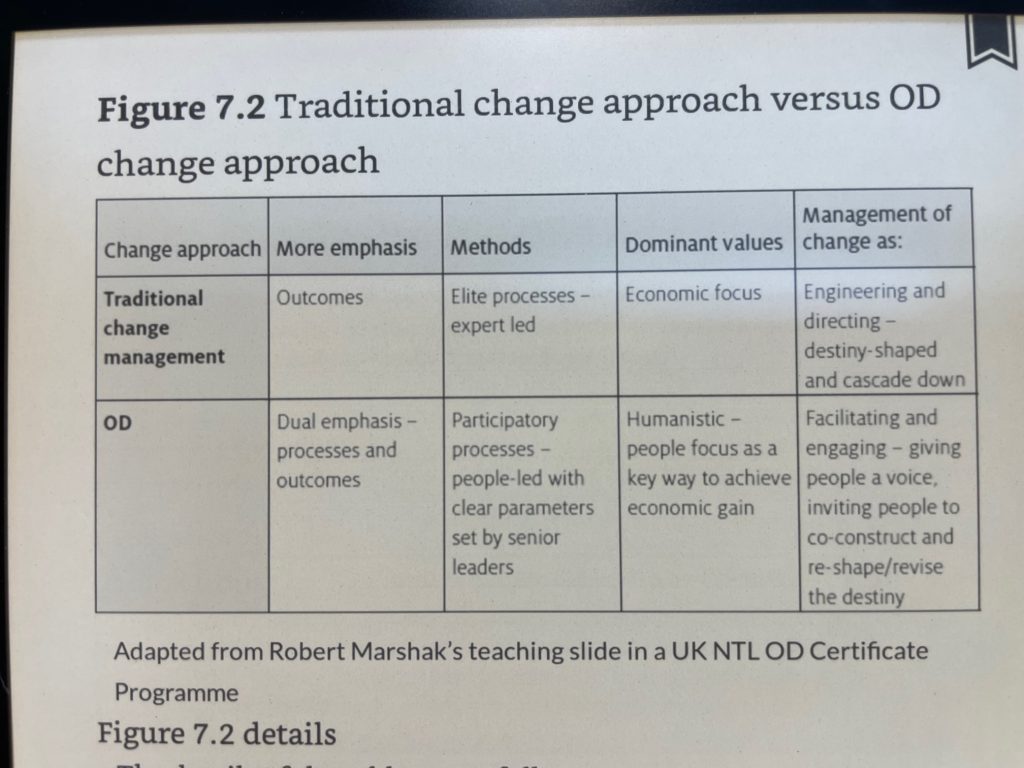
People do not resist change; they just resist being changed.
Change is NOT an event but a series of interventions, both planned and emergent, directed at
specific levels of the system.
08 Back-room and front-room change matters
1)Back-room matters (logistics, plan, infrastructure matters that support the change).
2)Front-room matters (the people dimension and the engagement issue).
‘Back-room change matters’ are also known as the macro matters because these are the essential major organization issues that require clarity before any form of change planning can take place.
there are real differences between those leaders who can hold their line and articulate what
the change is about and what it is aiming to achieve, and those who cannot.
The business case focuses more on the reasons why the organization needs or chooses to respond because of the challenges presented from within the organization or pressure coming from environmental factors.
The business case for internal driven change is often (but not necessarily) based on a deficiency lens – something does not work, or could work better, or needs to do better,
Conversely, the benefit case may come from organizations who have already dealt with the
competition issues, and hence can scale a higher summit, achieve greater market share, be known for giving greater and higher quality of service to their customers, etc.
Fig.8.2 levels of gains
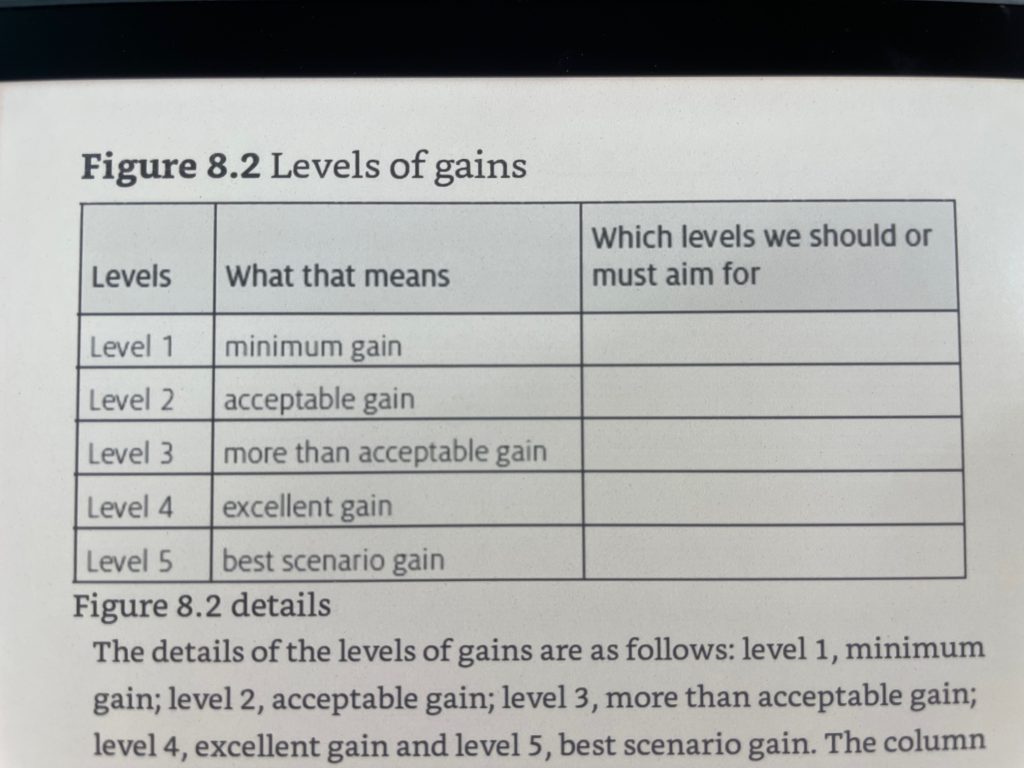
Fig.8.3 Types of change
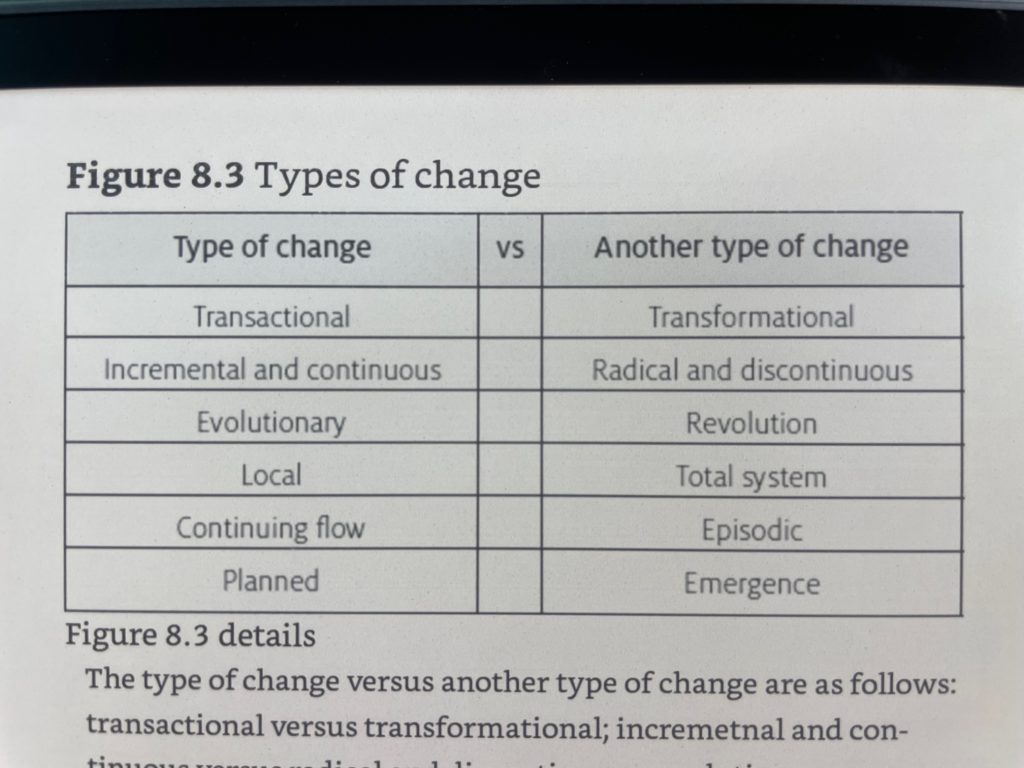
From Burke (2002) and Nadler’s (1998) definitions, we know all organizations are engaged
n transactional-incremental-continuous change as they try to eliminate problems and increase efficiency.
Transformational-radical-discontinuous change is drawn from the Latin word transformare, which means changing shape.
there are four categories of change: simple, complicated, complex and chaos, which hold different meanings from the above categories listed in Figure 8.3:
Fig.8.4
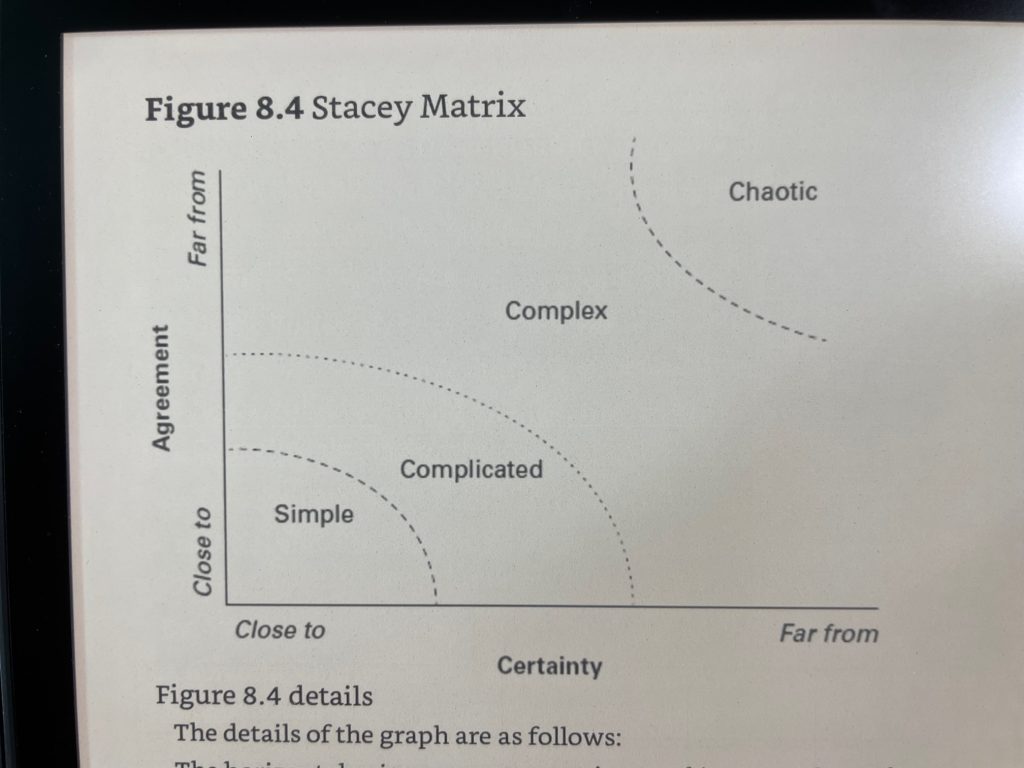
Fig.8.5
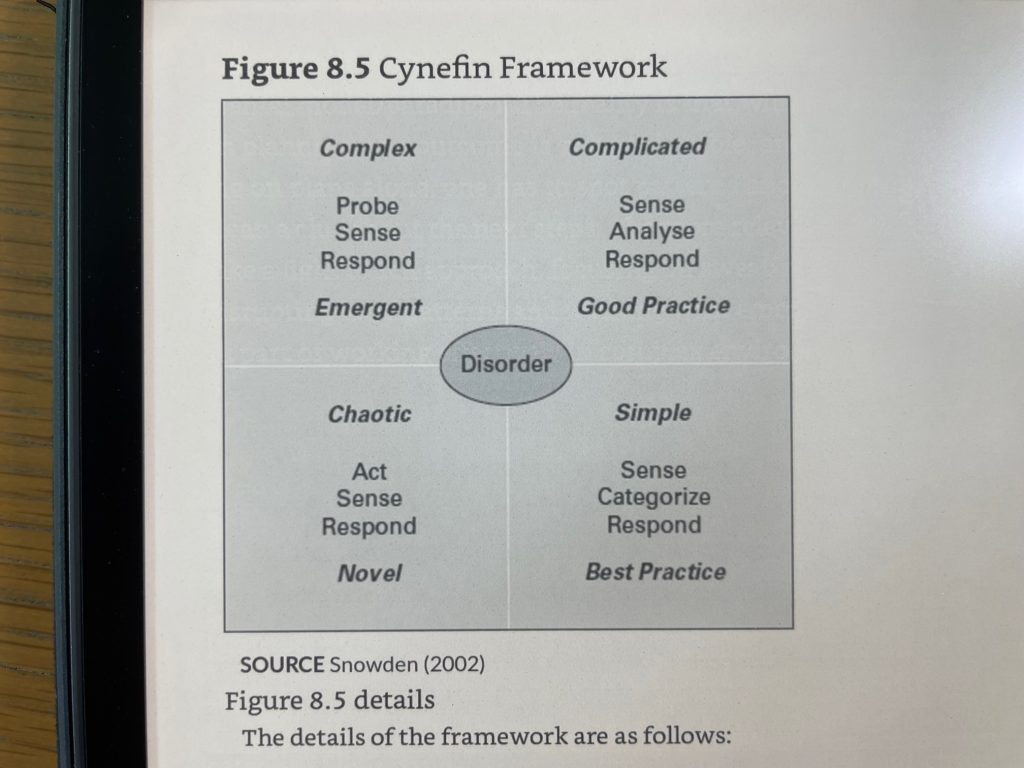
Insufficient change capacity has a more negative impact on the change work than one can imagine.
One way to increase the willingness of the executive to put realistic full-time resources towards support of the change is to align talent management with change resources.
By putting together across-functional talent pool to support the change work, the organization is building a future community of leaders who – by working together in the change journey – find themselves being changed in the process and relying on the group to support themselves in the continuous self-development journey.
Finally, the most critical alignment question we will need to ask is, ‘What type of mindset, paradigm or thinking will support this change initiative and what is the most sensible way for us to shift these inner models from the beginning?
At the end of working through the list of macro issues, a more robust change plan will be in draft form. However, that forms only half of the plan as the other half will come from working through the front-room issues.
Front-room matters are the heart and soul of change. Change is not successful until the people voluntarily shift their behaviour. So this is the heart of all change matters.
A) WHO ARE THE KEY GROUPS? DEFINITION
B) ASSESS THE ATTITUDE OF THE KEY GROUPS TOWARDS THE CHANGE, THEIR STATE OF SUPPORT TO THE CHANGE AND THEIR LEVEL OF ABILITY TO INFLUENCE OTHERS TO SUPPORT THE CHANGE
Fig.8.8
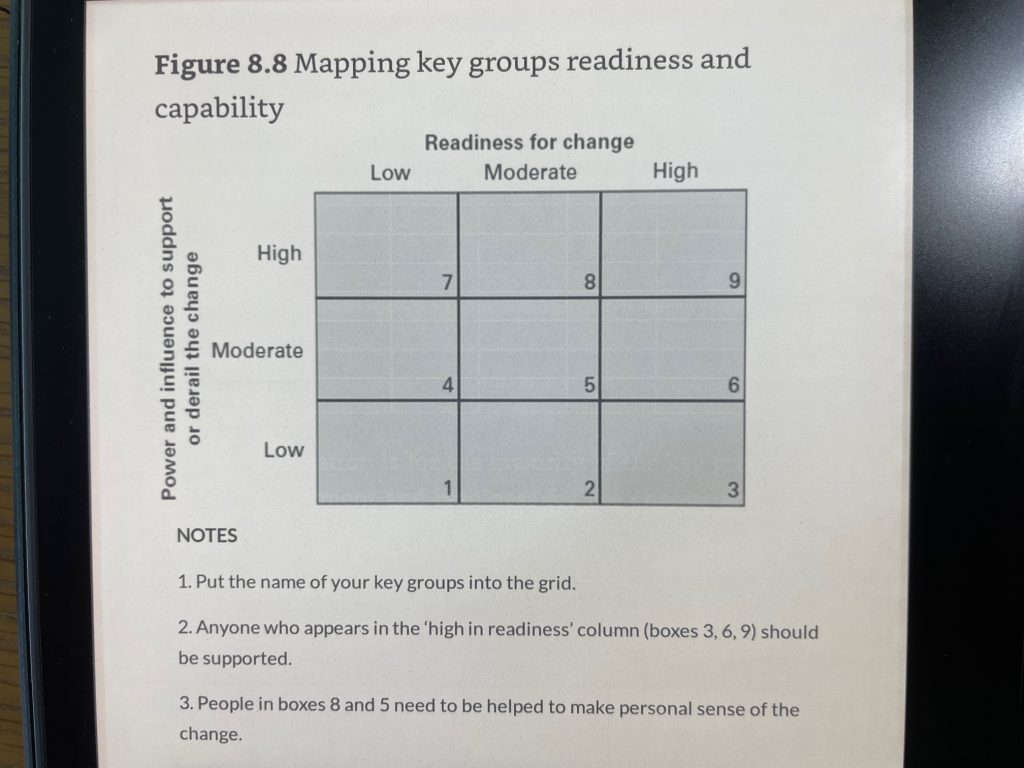
C) HOW TO USE GROUP DYNAMICS TO ENGAGE AND SUPPORT KEY GROUPS IN THEIR PERSONAL CHANGE
Fig.8.9
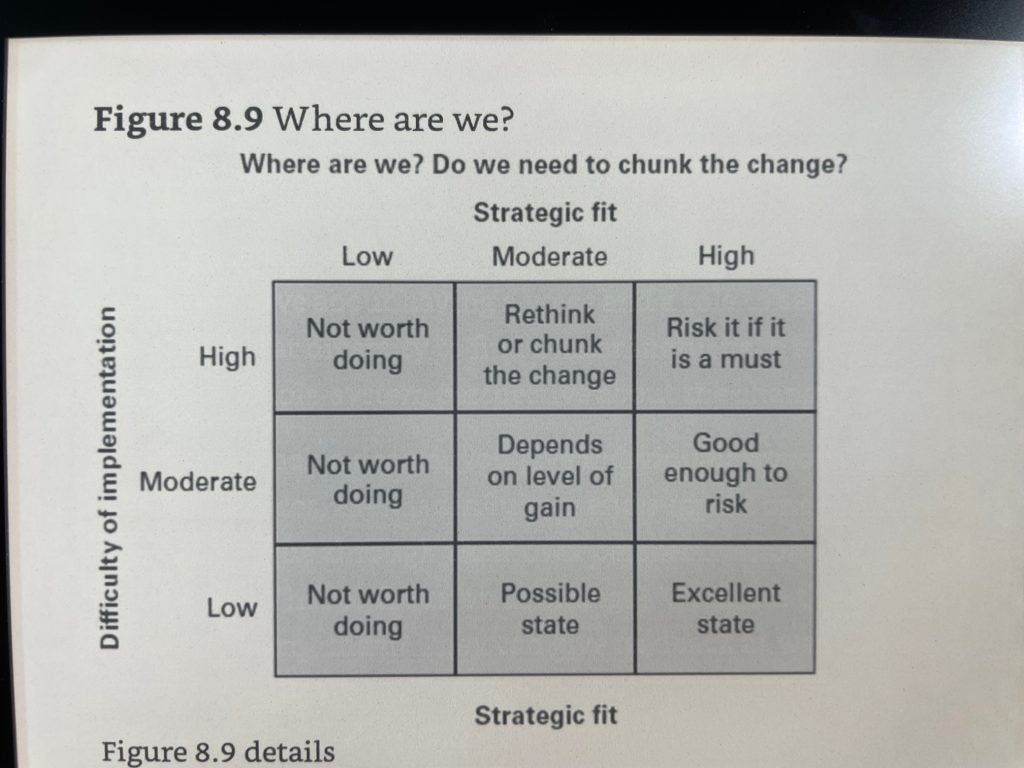
D) WHAT LEVEL OF CAPABILITY WILL WE NEED TO OFFER TO THE KEY GROUPS SO THAT THEY CAN SUPPORT THEMSELVES IN THE CHANGE PROCESSES?
E) SHIFTING OUR PERSPECTIVE OF RESISTANCE AND LEARNING HOW TO TAP INTO THE ‘RESISTAN
E ENERGY
While resistance is mostly rationally based, it is often emotionally expressed – you need to know how to work with both the rational and affective dimensions.
Put champions and resisters together to have a lively exchange about the pros and cons of the change(to enable both sides to listen to each other as well as influence each other as new perspectives are shared).
The success of any change depends on both getting the upstream issues right and ensuring the
change implementation journey, the downstream processes, are run effectively.
That is why Tawse et al (2019) called the transition from planning to implementation a
‘treacherous chasm’ where good intentions in planning simply do not and could not make it to the other side.
So who should own such capabilities? The answer is the organization, because this is not just a matter of individual change agent competences, but a corporate mindset that places premium importance on such capabilities and is willing to invest properly to build up these capabilities.
In order to achieve successful implementation, there are four key areas that change leaders
need to pay full attention to during the implementation period.
The change implementation capabilities:
Ensure everyone owns the change – use both military- and marketing-style campaigns to win support.
two years after a change effort had ended, those companies still sustained twice the level of financial benefits of the poor implementers.
All the front-room work is to ensure people will have space to take part in the change process
The focus of this work is both engagement and to gather robust data from people in every
part of the organization.
All the back-room work is to ensure the change is approached and set up in as rational and logical a manner as possible – especially since all complex changes require an effectively run back office.
It is a ‘both-and’ not an ‘either-or’ approach. Our job is to excel in our ability to integrate the front- and back-room matters to form a robust change plan.
Fig.8.10
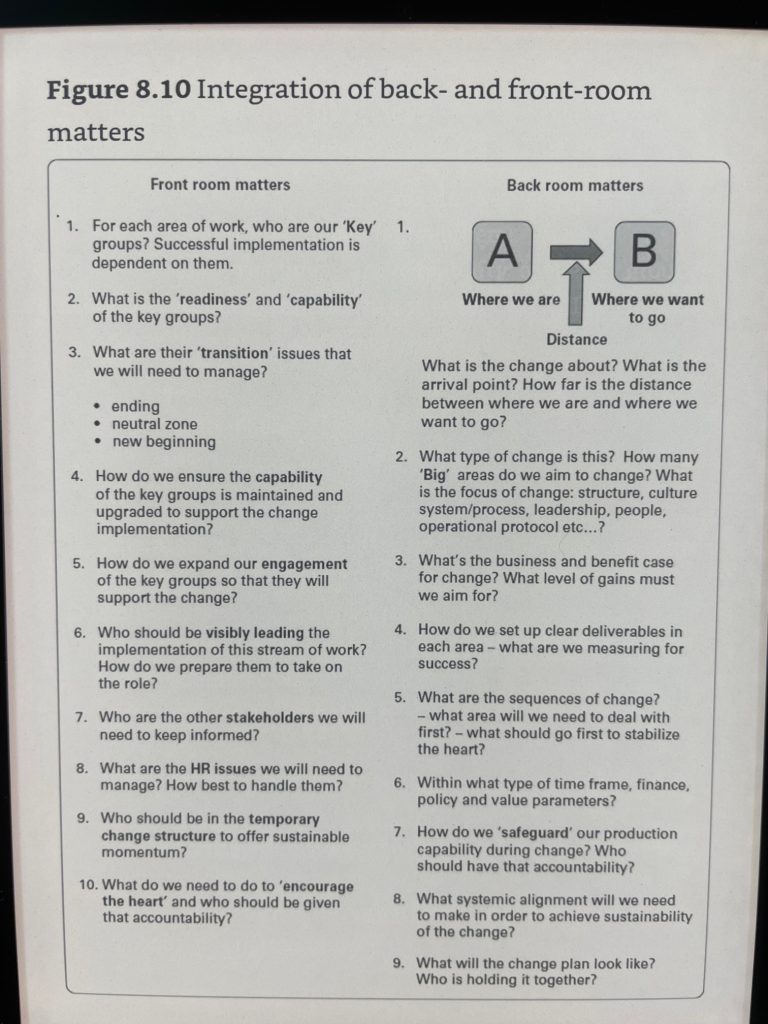
09 Can behavioural change be made easy?
However, among those 30 per cent of change initiatives that succeed, the common characteristic is the ability to change individual employee behaviour.
There are over 30 definitions of culture; they can be summarized as the commonly held and
relatively stable beliefs and attitudes that exist within an organization.
culture means the way people think and do things around here.
Once culture is formed, there is a powerful evaluative connotation attached to it as the
organization clearly uses it to delineate what is ‘acceptable’and ‘unacceptable’ behaviour, which the organization will reward or punish.
This approach do not focus on‘culture change’, it focuses on how to align behaviour to what is desired.
Fig.9.1
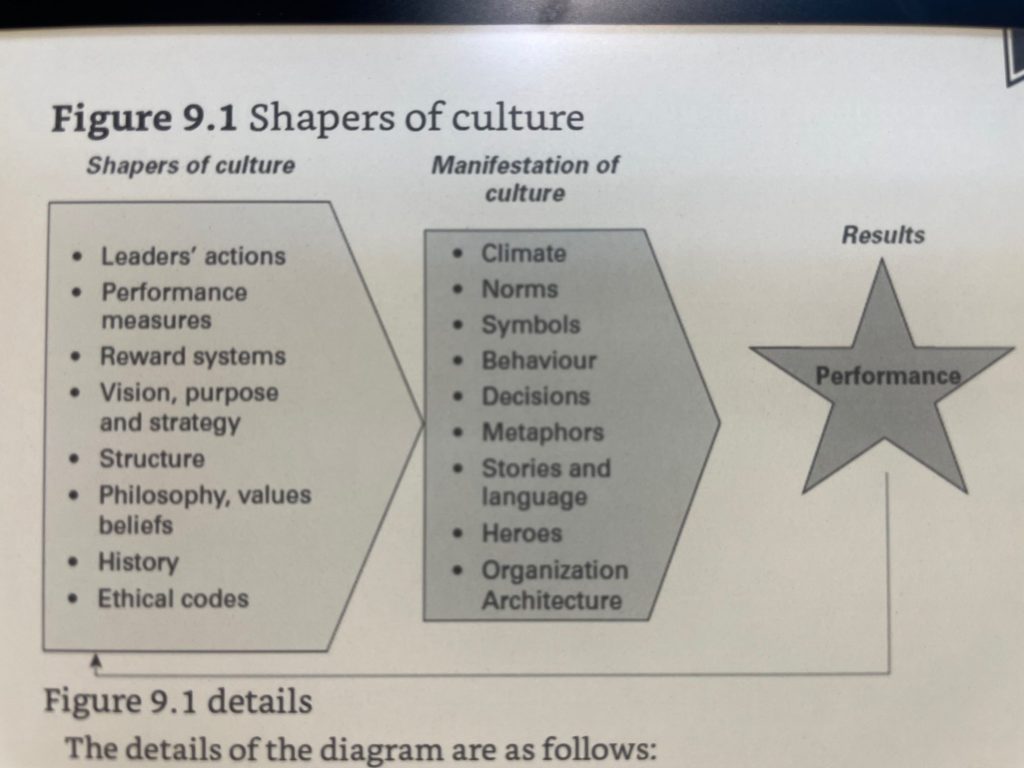
The key point that emerges from this anthropological view is that culture exists not so much
inside or outside but ‘in-between’ people.
In other words, patterns are much more recognizable and identifiable than ‘culture’, something that members of any system can be helped to understand and use. This is the reason why focusing on pattern shifting rather than culture change makes the work in behavioural change easier and more accessible for members within the organization.
four ways that can also aid in the pattern-shifting work that needs to start from day one.
Marshak and Grant (2011) who believe that ‘talk reflects how the person sees reality; and talk informs and shapes action
In 1987 Professor Richard Thaler published an article on ‘Psychology of choice and the assumptions of economics’ and later on, in 1991, a book, Quasi Rational Economics. He is considered the father of behavioural economics,
Thaler has inspired scholars across different disciplines and fundamentally changed the way we think about human behaviour.
The first way to change behaviour is based on influencing how people consciously think. This is often called the ‘rational’ or ‘cognitive’ model.
The second way to change behaviour is more about moving away from facts and information alone, to a contrasting model that focuses on the more automatic processes of judgement and influence by altering the context within which people act.
Fig.9.5
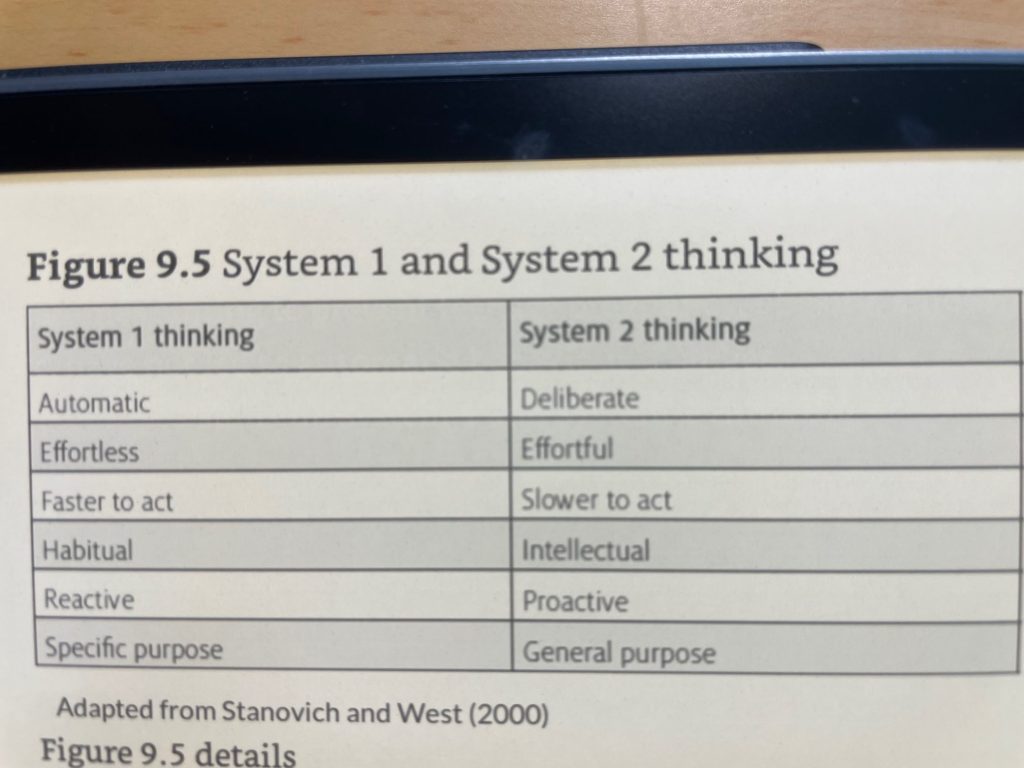
The key thing you have to remember is that habit formation is crucial to behavioural change
because most behaviour is automatic, as our brains rely largely on our fast, intuitive System 1 to conserve limited cognitive energy.
This third way that helps to support behavioural change can be an uncomfortable area for many applied behavioural scientists.
For Glenda, all behavioural change points towards the ability to act in a self-organized way.
Section 4 The Organization Development practitioner
When an ODP has the relational and power dragons living in harmony, s/he will experience
resourcefulness, competence, authenticity, community and confidence to do what s/he sets out to do.
10 The Organization Development practitioner
Always approaching work from the total system approach (ODPs are committed system thinkers and whatever process design work you use, it will be informed by a systemic view).
OD practitioners are behavioural scientists who, through effective relationship-building skills, deliver help and support to a client system with the dual goal of improving the performance as well as the internal health of the system.
Within this self, there is a known and unknown (persona and shadow) aspect (Jung, 1921).
One has to bear in mind the backdrop against which OD entered into Western society after WWII and the Holocaust.
Use of self, as believed by OD founders, creates a more powerful and compelling engagement
between the helpers and those who are being helped.
‘Perhaps the most powerful instrument we have in helping our clients navigate change is
ourselves’
11 Power and politics in Organization Development
Most of them, especially in the West, are pluralistic in nature because pluralistic organization is a trademark of democracy.
Politics is the processes, actions and the behaviour you use to achieve the influence you desire,
There are many reasons that may have led to the ambivalent attitude towards power among ODPs.
According to McClelland (1970) there are two faces of power, which operate very differently, and they must not be confused. They are the negative face of power and the positive face of power.
The negative face of power is the ‘unsocialized’ way of using power, ie when people
use power in a negative way, they tend to dominate and control others often to benefit a single party (the power user).
The positive face of power is characterized by a socialized use of power, where the user
tends to have an empowering impact.
In essence, you will need to demonstrate to your client your own willingness to engage in
power and politics, and to show that power play is not only legitimate but also necessary, especially in times of change.
Section 5 Additional thoughts
12 What is an organization? What is organization health?
Fig.12.5
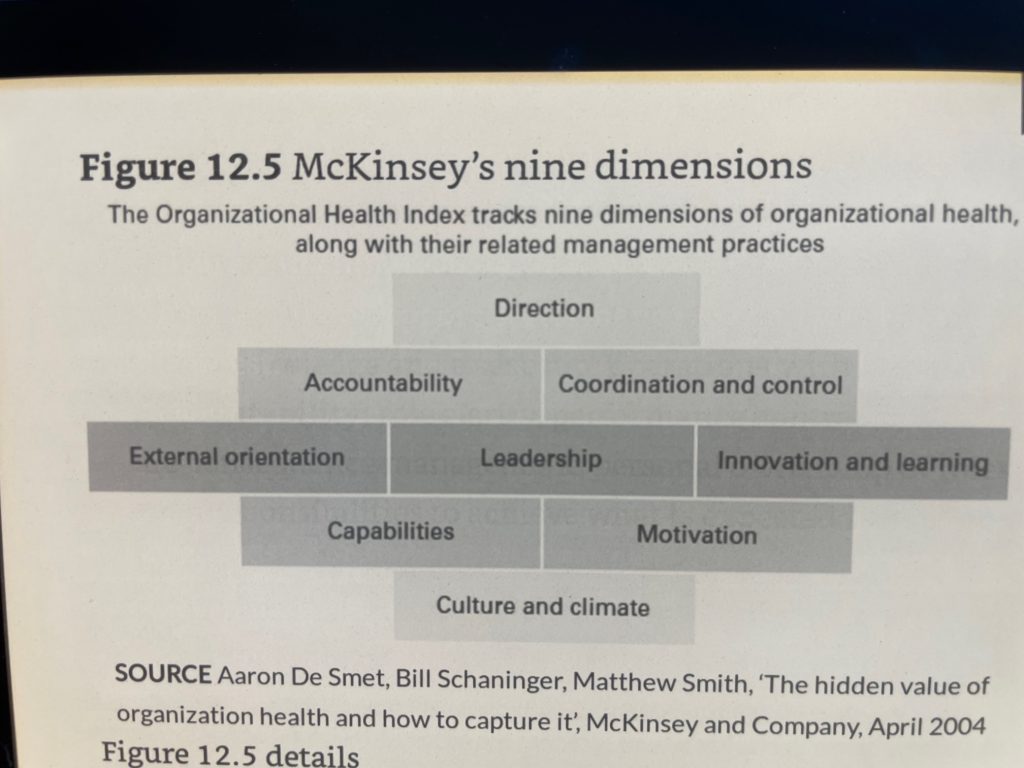
This is a risky chapter to write, as just to mention there is a prototype of organization health, or highlighting the McKinsey Consultancy effort, or overly drawing unproven conceptual work from a wide range of writers, will lead some people to dismiss this chapter.
However, I regard the risk as worth taking because if we are not clear about what a healthy
organization is, we will find our work rudderless.
13 How to build up your presence and impact on organization life
if the organization has seven divisions and each, in the past year, has engaged external consultants on average 50 days per year, then the total would be about 350 days (this may be a very conservative calculation). Given the average consultant’s daily fees are roughly £1,500–£2,500 ($2,000–$3,000), the sum will average between £525,000 and £875,000 ($700,000 and $1,050,00) before adding expenses to the total cost.
14 HR in relation to OD
In fact, in most organizations today the only constant is change.
HR as a discipline emerged in the 1980s at another time of fast change following a period of
significant industrial unrest in the UK and United States.
HR is based on unitarist assumptions, ie that employers hold the power in the employment
relationship and that what is good for the business is good for the people and vice versa.
for years HR has been criticized for being too reactive and internally focused.
For HR professionals working in small- and medium-sized enterprises (SMEs), the OD and HR
challenges may be different from those in a large organization.
The focus of an HR role will therefore differ between organizations according to workforce size,stage of growth, maturity, industry, the nature of job roles and the owner/founder’s ambitions for the business.
The global COVID-19 pandemic of 2020 has presented countries, organizations and individuals with the greatest challenge in living memory, resulting in unprecedented changes in the ways businesses operate and the ways we lead our lives.
For many HR teams the pandemic was their finest hour.
What seems clear is that the ‘deal’ between employer and employee is shifting.
employees are able to work more flexibly and potentially have more autonomy about when and
how they work.
CEO – whose focus is typically on the system input, ie the changing market demands and other
external environmental factors, and the output, or results.
HR and OD work on the troughput – what happens within the organizational system; their focus is on how this can be improved to make sure that the output matches the input.
OD in particular has strong humanistic, democratic values and participative methodologies that ensure that people have a voice in the way change is handled.
Change is not something done ‘to’ people but done ‘with’ people.
The art of the OD specialist (what Mee-Yan calls ‘magic’) is the skill of using the right process to help clients to solve their own problems.
HR in contrast relies more on content expertise, often playing an advisory role, giving direct guidance on employee cases.
Stereotypically L&D professionals are between these two approaches – with a body of content
or particular methodologies, and also ‘up-front’, catalysing and leading learning and training processes with individuals and groups.
15 Organization Design
Organization Design is conventionally associated with the ‘technical’ top-down aspect
of organizational structure and system change. Its fundamental premises are about economic rationalization.
Organization Development is about building healthy and effective organizations.
The antecedents of contemporary Organization Design theory can trace their roots back to
scientific management, the time and motion studies, and classical hierarchy
studies of the 1920s and ’30s.
Jay Galbraith’s ‘Star Model’ remains one of the best-known and most influential organization design frameworks.
16 Transformation and culture change
The high failure rate of mergers used to be ascribed to the content of change – the weak rationale and lack of strategic fit. Nowadays there is much wider recognition that the main causes of failure lie in the process of change and how it unfolds and especially in the consequences of change for people and culture.
Of the many model to explain the psychological shifts many employees experience as they are
affected by change, Elizabeth Kübler-Ross’s Bereavement Curve (1973) and William Bridges’ Transitions model (2004) are among the best known in management circles.
Stokes and Harrison (1992). They argue that it is better to think more in terms of ‘strengthening’ and ‘balancing’ an organization’s culture than of ‘changing’ it.
Appreciative Inquiry (Cooperrider and Srivastva, 1987) is perhaps the best known of the
strengths-based approaches.
The gateway to success or all types of change is to engage key staff in the changes sufficiently that they help shape sustainable change outcomes.
17 Building organizational agility and resilience
agility is now more broadly defined as an organization’s capability to respond and adapt quickly and effectively to the changing environment (McCann et al, 2009).
Two investment decisions, in particular, will be crucial to shaping the future of jobs:
the question of whether to prioritize automation or augmentation and the question of whether or not to invest in workforce reskilling (WEF, 2018).
PwC (2011) advocate that functions such as HR should adopt the three ‘S’s
simplify, overly complex processes;
standardize – processes that can reduce cost and improve the customer experience;
share – spread new effective practice to benefit the whole organization.
18 A culture conducive to innovation and learning
What distinguishes innovation from creativity is the implementation rather than simply the
generation of ideas (Sarooghi et al, 2015).
This suggests that companies need to strike a dynamic balance between exploitation (maintaining efficiency and exploiting their existing business models to the full) and exploration (of new opportunities and new business models), which will vary according to circumstances. They must manage the trade-offs between efficiency and innovation.
HR’s task is to work with leaders to create a context of psychological safety (Edmondson, 2008)in which it is OK to challenge, experiment, learn and occasionally make mistakes.
19 Building the context for employee engagement
today’s knowledge- and service-intensive economies, people are the main source of
innovation, production and service excellence.
The state of employee engagement is generally characterized by what Csikszentmihalyi (1990)
describes as ‘flow’ – where people are so pleasurably immersed in their work that they freely release their ‘discretionary effort’.
However, at the other end of the engagement spectrum is burnout (Maslach et al, 2001).
There are reportedly five generations in the workforce currently – ‘Traditionalists’,
‘Baby Boomers’, ‘Gen Xers’, ‘Millennials’ or ‘Gen Y’ and ‘Gen Z’ – and arguably each needs to be managed with an understanding of their specific needs, expectations and motivations.
20 Developing effective leadership
So great are these challenges that Gary Hamel and Bill Breen (2007) suggested that many
managers are ill-equipped to deal with them.
Why is leadership so key? Like it or not, many surveys report leadership, or lack of it, as the primary reason why people either choose to stay with their employers and
give of their best, or leave; or worse still, stay but become cynical and find work meaningless.
But I’m afraid that I have to agree with Augier and Teece (2005) when they say, ‘As
a scientific concept, leadership is a mess’.
how definition of ‘effective’ leadership are changing.
Leadership is increasingly defined not as what the leader is or does but rather as a process that engenders and is the result of relationships – relationships that focus on the interactions of both leaders and collaborators instead of focusing on only the competencies of the leaders.
Yet HR professionals often find themselves in a dilemma. While their organizations are
asking them to become leaders and partners in running the business, they are
frequently asked to implement initiatives and programmes over which they
have no formal authority or with which they disagree.
In his seminal article‘Teaching smart people how to learn’ (1991) Chris Argyris points out
how defensive thinking is commonplace among knowledge workers.
Postscript – towards a better tomorrow
===

コメントフォーム